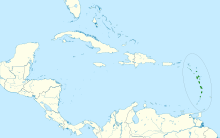Purple-throated carib
| Purple-throated carib | |
|---|---|

| |
| Purple-throated carib in Morne Diablotins National Park, Dominica | |
| Scientific classification | |
| Kingdom: | Animalia |
| Phylum: | Chordata |
| Class: | Aves |
| Order: | Apodiformes |
| Family: | Trochilidae |
| Genus: | Eulampis |
| Species: | E. jugularis
|
| Binomial name | |
| Eulampis jugularis (Linnaeus, 1766)
| |

| |
| Synonyms | |
|
Trochilus jugularis Linnaeus, 1766 | |
The purple-throated carib (Eulampis jugularis) is a species of hummingbird in the family Trochilidae.
It breeds on Antigua, Dominica, Guadeloupe, Martinique, Montserrat, Saba, Saint Kitts and Nevis, Saint Lucia, Saint Vincent and Sint Eustatius. It has occurred as a vagrant in Barbados, Barbuda, Grenada and the Virgin Islands.
Its natural habitats are subtropical or tropical moist lowland forest and open spaces.
The purple-throated carib is notable for the differences in the appearance of the sexes. The male is larger and stronger than the female and has a shorter straight beak. Her beak is curved and about 1/3 longer.
Taxonomy[]
The purple-throated carib was formally described by the Swedish naturalist Carl Linnaeus in 1766 in the twelfth edition of his Systema Naturae under the binomial name Trochilus jugularis.[2] Linnaeus based his short description on the "red breasted humming bird" that had been described and illustrated by the English naturalist George Edwards and the "colibry violet de Cayenne" that had been described and illustrated by the French zoologist Mathurin Jacques Brisson.[3][4] Edwards believed his specimen had come from Suriname, Brisson believed his specimen had come from Cayenne, but both authors were mistaken, the purple-throated carib is only found on the islands of the Lesser Antilles.[5] The specific epithet jugularis is Medieval Latin for "of the throat".[6] The purple-throated carib is now the type species of the genus Eulampis was introduced in 1831 by the German zoologist Friedrich Boie.[5][7] The species is monotypic: no subspecies are recognised.[8]
See also[]
References[]
- ^ BirdLife International (2016). "Eulampis jugularis". IUCN Red List of Threatened Species. 2016: e.T22687151A93142404. doi:10.2305/IUCN.UK.2016-3.RLTS.T22687151A93142404.en. Retrieved 13 November 2021.
- ^ Linnaeus, Carl (1766). Systema naturae : per regna tria natura, secundum classes, ordines, genera, species, cum characteribus, differentiis, synonymis, locis (in Latin). Volume 1, Part 1 (12th ed.). Holmiae (Stockholm): Laurentii Salvii. p. 190.
|volume=has extra text (help) - ^ Edwards, George (1760). Gleanings of Natural History, exhibiting figures of quadrupeds, birds, insects, plants &c... (in English and French). Part 2. London: Printed for the author, at the College of Physicians. p. 118 Plate 266.
- ^ Brisson, Mathurin Jacques (1760). Ornithologie, ou, Méthode Contenant la Division des Oiseaux en Ordres, Sections, Genres, Especes & leurs Variétés (in French and Latin). Volume 3. Paris: Jean-Baptiste Bauche. pp. 683–685, Plate 35 Fig 3.
|volume=has extra text (help) - ^ a b Peters, James Lee, ed. (1945). Check-List of Birds of the World. Volume 5. Cambridge, Massachusetts: Harvard University Press. p. 27.
|volume=has extra text (help) - ^ Jobling, James A. (2010). The Helm Dictionary of Scientific Bird Names. London: Christopher Helm. p. 212. ISBN 978-1-4081-2501-4.
- ^ Boie, Friedrich (1831). "Bemerkungen über Species und einige ornithologische Familien und Sippen". Isis von Oken (in German). Cols 538–548 [547].
- ^ Gill, Frank; Donsker, David; Rasmussen, Pamela, eds. (January 2021). "Hummingbirds". IOC World Bird List Version 11.1. International Ornithologists' Union. Retrieved 6 March 2021.
External links[]
 Media related to Eulampis jugularis at Wikimedia Commons
Media related to Eulampis jugularis at Wikimedia Commons
- IUCN Red List least concern species
- Eulampis
- Birds of the Lesser Antilles
- Birds described in 1766
- Taxa named by Carl Linnaeus
- Hummingbird stubs
